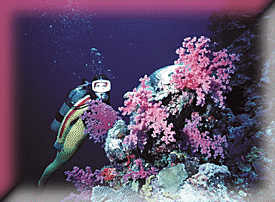|
Q. Where is the world's best diving?
|
A. Wherever God put it. In other words, not necessarily convenient airports or shore based diving. In the Pacific and Red Sea, this can mean hundreds of miles away. |
|
Q. Is that why people trade the space and comfort of a hotel to live on a dive cruiser?
|
A. Absolutely. For thirty years now, sophisticated divers have traded shopping, tennis and sitting around a hotel to get unlimited diving on superior, undamaged reefs. Live-aboards are the only way to reach those sites. Another secret at the heart of live-aboard diving is VALUE, as signified by the COST PER DIVE. Simply put, it means that when you purchase a dive vacation, the total cost (airfare, hotel, meals, transfers, taxes, etc.) can reach $2500 to $5000 per person. Using a $2500 total as an example, consider this: If you do ten dives that week each dive will cost you $250. If instead you go on a quality live-aboard and do thirty dives that week, your cost per dive is only $83! That is value... |
|
Q. What do you mean by "unlimited diving"? |
A. Unlimited diving means that you can go diving any time the cruiser is not in transit to a new place. Some divers do three dives per day using this freedom, others will do as many as seven. It genuinely is up to you. |
|
Q. Will I be comfortable living on a live-aboard for a week or more?
|
A. Modern, well-managed live-aboards offer comfort, cleanliness and convenience equal to that of a dive resort. Many now have water makers, ice cube dispensers, and E-6 processing in addition to comforts such as clean linens, private baths and queen-sized beds. There are, of course, boats which don't have everything listed, but the comfort standard rises each year. |
| Q. How many divers are on a typical live-aboard cruiser? | A. There is no such thing as a typical live-aboard cruiser. Some are built for four passengers, or six; the larger vessels host up to eighteen. Each derives its uniqueness from its marine life, its comforts and the nature of its crew. The best ones offer unforgettable adventures. |
|
Q. Is there a problem with seasickness?
|
A. That depends on the locale. Places such as Palau or Papua New Guinea or Truk Lagoon offer lots of shelter in any weather. More important, I try to schedule all clients on cruises during what have historically, been the calm-weather months. Remember, the dedicated boat crews don't want to endure rough water, either. They know their area, and arrange their itineraries for maximum comfort. |
|
Q. What do you do when you aren't diving?
|
A. You'd be surprised how much of the day is consumed by diving when you are at world-class sites. In addition, modern live-aboards offer TV-VCR's, audio systems for music, sun-deck or salon for reading and interesting divers with whom to share your diving adventures. The explosive growth of live-aboard diving is a testament to its clear superiority as seen by sophisticated divers. |
| Q. What does everyone do in the evenings? | A. Believe it or not, an active day of diving, sun and salt air uses a lot of energy. There are evening movies or slide shows, but many divers sleep well after several dives. |
| Q. How can you really have privacy on a dive cruise? | A. Modern live-aboards offer privacy equivalent to that of a hotel. Many have private suites, queen-sized beds and private bath/showers. The social areas are increasingly spacious and comfortable. |
| Q. If that is true, a lot of divers should be switching from hotels to live-aboards. Are they? | A. Live-aboard diving has a powerful growth rate, almost all of which is comprised of divers abandoning shore resorts. Over the years, more than 95% of those who try a quality live-aboard never take another hotel-based vacation. |




